|
|
|
|
||||||||||||||||||||||||||||||||||||||||||||||||||||||||
NWF Green Hour |
||||
Commentary on what parents should know about and can do to counteract common "nature deficit disorders" in our TV-watching, video game-playing children including encouraging a daily "Green Hour" of outside play and learning. A program of the National Wildlife Federation Monday, August 29, 2005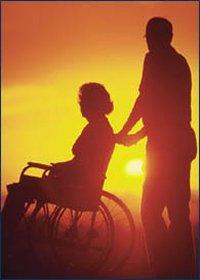 Five Years off a Child's Life? Outdoor activity will improve fitness and lifespan. A spate of information on childhood obesity relates it, in part, to too much TV watching and consequent physical inactivity. Here is an example. Now researchers in Chicago and Boston are looking at the implications for the nationwide childhood obesity epidemic for shorter lifespan and a poorer state of lifetime health. They conclude that, while we have enjoyed increases in expected lifespan for several decades, the new lack of childhood activity and its extra pounds will actually shorten average lifespan. Main risks occur in childhood and are parent and care-giver responsibilities. One more good thing about a daily Green Hour of outdoor play and learning is a longer life. Read More. Sunday, August 28, 2005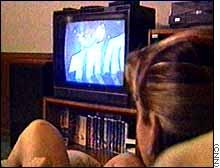 A Daily Green Hour early -- Succeed in life later Recent study says getting kids away from TV greatly improves college chances A University of Otago (NZ) study reports: "Kids who watched the least TV – especially between the ages of 5 and 11 – had the highest probability of graduating from university by the age of 26, regardless of IQ or socioeconomic status. While those who watched the most TV, more than 3 hours per day, had the highest chance of dropping out of school without qualifications." Two other studies confirm similar findings but also suggest that a limited amount of true educational programming might actually help with learning, but few families succeed at finding the right balance. We think more creative time outdoors -- an hour per day learning, having fun, relaxing and relating is the best alternative to TV. Read More! Saturday, August 27, 2005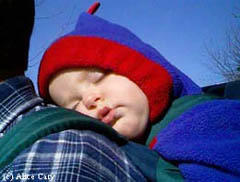 Babes in the Woods A Parents Guide to Getting Outdoors Some parents worry about even being able to get their children outside -- smart folks in the travel industry see this as a huge issue and are responding accordingly. Check out Gorp.com which is part of the away.com network. They have an on-line family expert, Alice Carey, who writes thoughtfully on the subject with lots of good advice. One recent feature -- "Baby in the Woods" provides advice to parents of very young children. Alice also has advice for getting older kids outdoors too. Photo from Gorp.com website Wednesday, August 24, 2005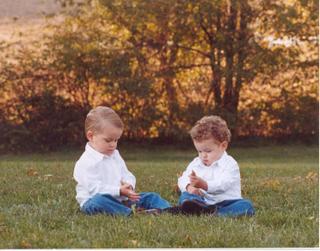 Early Wonders Nature Deficit Needs to be Addressed at the Beginning. Young children need to spend more time outdoors too. Recognizing this, and the fact that most organized environmental education starts at about age 9-10, a number of Minnesota educators teamed up to develop an outstanding pre-school guide entitled Natural Wonders: a Guide to Early Childhood for Environmental Edcuators. It is important because many children form their personal values by age six or seven and they always seem to have natural love of animals. Check it out at Minnesota's SEEK website. Saturday, August 20, 2005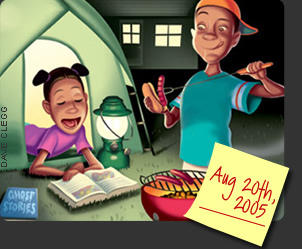 Backyard Campout Tonight Sometimes it's about the food! The National Wildlife Federation's Green Hour Program is about reversing the nature deficit disorders we find in today's kids. They are spending an average of six hours per day glued to TV and other electronic screens. Most Kids are -- after the shock of stepping away from the computer -- delighted to be playing outside and even having a backyard campout. Some kids may require more incentives though. We recommend bait! Take 1 graham cracker, break in half. Break off 2 blocks of chocolate candy bar. Place candy on cracker, then place 1 marshmallow on top of candy. Put other half of cracker on top of marshmallow. Squeeze over long-handled fork or stick. Hold over heat until melted. Squeeze it together a little more (smore) and serve. NWF's Great American Backyard Campout Happy camping! Thursday, August 18, 2005 A Great American Family Thing NWF's Great American Backyard Campout has, at this writing, 30,000 campers enrolled for the evening of Saturday August 20, 2005. They will be at 3,000 different locations. The excitment is palpable as people continue to sign on a rate of 2,000 per day and the media is calling wondering who in their area might be available for an camp-side interview. While it might seem pretty obvious, the campout has indeed turned into a real family affair with parents and children getting into the outdoor groove together. We decided to check out a little background on camping as a family activity and found it really measures up. Kids love it. The food tastes a little better. It is a real adventure. And, importantly, it turns hours of relating only to TV and computers into hours of real contact with people, natural sounds, unusual experiences, outdoor air and greenery, Check it out! Monday, August 15, 2005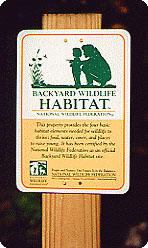 One Backyard at a Time Our Green Hour Program is about nature that is easily accessible to children and families. Let's try to get outside an hour a day in a green space of your choice starting close-to-home. Recently Discovery's Animal Planet teamed up with the National Wildlife Federation on a new TV series called Backyard Habitat. It premiered today and is another example of how the electonic media can be a good thing when it encourages people to get outside in green spaces and be more active. Backyard Habitat will air each weekday through September. It supports the simple idea that every home-owner and apartment dweller can create a "backyard" wildlife habtitat. It can be large-scale or it can be as tiny as a few potted plants, a feeder and a bird bath on a balcony in the city. The main idea is we need to keep finding ways to connect with nature and to help others do so even if it is just through one backyard at a time. Saturday, August 13, 2005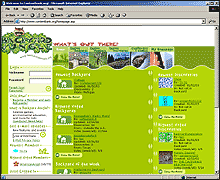 It's a Jungle Out There! Some websites can move children outdoors National Wildlife Federation's Great American Backyard Campout partner, PBS Backyard Jungle, has developed an exemplary blend of the virtual and real worlds. The Backyard Jungle website provides young people with the opportunity to develop an on-line map of their very favorite outdoor space. To do this, they need to get outside and explore. Once the child has takena close look at, let's say, their backyard, he or she will map it by filling it with the right symbols and icons and then post the map on the Web. The kids also can post their comments and observations and share them with other kids. For the August 20, 2005 Great American Backyard Campout, our friends at the Corporation for Public Broadcastng and the Jungle's remarkable site-creator, Forum One Communications, have added a tent icon to the map options! At this writing almost 22,000 people are signed up for the Backyard Campout -- we hope you will join us. Monday, August 08, 2005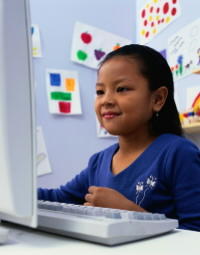 Green, Healthy and Safe So How About Safety Outdoors vs. Safety On-line? There are many reasons children need to spend more time outside and get away from an average of six hours a day in front of electronic screens. In his outstanding book, "Last Child in the Woods" author Richard Louv notes that parents are often nervous about their kids being outside and maybe falling and getting hurt or becoming prey to child molesters. We agree that a child has a greater chance for a skinned knee outdoors than sitting at a computer. And, national television news has recently been full of tragic and alarming stories of sexual predators. So, while we might not recommend the kind of extensive hours of outdoors "free-ranging" that many older adults engaged in as children, we think it is still important for parents to let their kids get outside in nature an average of an hour per day. First, there are actually fewer instances of child predation than there were years ago. This is one crime rate that has gone down. Secondly the Internet is a vastly greater threat. It exposes one in five children to direct communication with a sexual predator and offers tens of thousands of such predators the opportunity to lurk on the Web and communicate freely with one another and the kids of their choice. There are many safe outside places close to home starting with the backyard and kids mostly play in groups and pairs when outdoors rather than in isolation at the computer screen. To learn more about online safety pitfalls, see: http://www.protectkids.com/dangers/onlinepred.htm Saturday, August 06, 2005 In Green Shape Getting young people outside means more than letting them experience trees, open spaces and streams. Simply being outside enlivens a child. That usually starts them moving and that makes them more fit. Basic fitness is a vanishing state among our children. Fully one third are now officialy overweight and it affects both their physical and emotional well-being. Indiana University published an outstanding article on the subject. Check it out! Thursday, August 04, 2005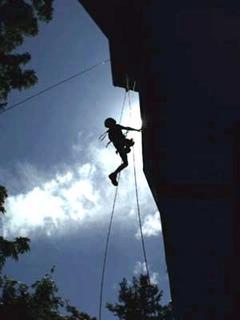 Outdoor Activities Down Among Young Adults Beginning Sign of Nature Deficit? The survey research firm of Roper has identified a fast-developing decline in outdoor activities among young adults ages 18-29. These include hiking, biking and other classic outdoor recreation pursuits. In a 2003 report, Roper identified the recent shift (compared to its 2001 and prior studies of outdoor recreation). The study also finds an increase in the use of "electronics" in leisure-time. People aged 30 to 44 (25%) and aged 45 to 59 (22%) are more likely to be "frequent" recreators than the 18-29 group (19%) -- this is a first. The researched was commissioned by the American Recreation Coalition and is part of a series that can be viewed at www.funoutdoors.com Making sure our kids are getting more time outside -- a green hour (av.) per day -- is also key to later adult outdoor activity habits. Tuesday, August 02, 2005 Parenting in 2005 -- Inside and Out In the late 20th Century, two somewhat contradictory trends occurred simulataneoulsly. First, we learned that raising children is really called "parenting" and involves paying more attention than ever to a child's well-being and development. Second, under our noses, children became almost completely wired and, what began as concern about too much gawking at the "boob tube," evolved to a new-found preoccupation with e-mails, text messages, instant messaging, game boys, DVDs and more. Now we need to look at "parenting" in this new cyber-hued light. There are many reasons why parents should get their kids away from electronic screens and off the sofa -- fitness, less agitation, higher self esteem, creativity and more. And, there are wonderful reasons to spend some of that time new-found time outdoors. Consider camping. Camping? -- Am I kidding? In the old days, kids used to love outdoor camping. But what about these days? Most kids still love camping but it is now so unfamiliar to them they will likely protest the very idea. Still, camping is a proven way to spend time good with kids and strenghten those ever-challenged parenting skills. On August 20th the National Wildlife Federation is hosting the Great American Backyard Campout. It makes camping simple and fun and you can do it right in your own backyard -- or on the patio or in any friendly and familiar outdoor space. Click on: www.backyardcampout.org to sign up and see what it is like. Or -- for more camping information -- you can check out: http://childparenting.about.com/od/familyvacationideas/a/campingfamily.htm Monday, August 01, 2005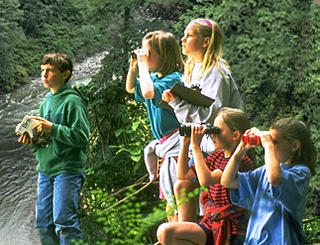 The Difference Between Green and Gray. Why place so much emphasis on a daily "green" hour? A 2001 study, released by University of Illinois, found that a daily dose of Mother Nature helped children with attention deficit disorders. It found that children with Attention Deficit Hyperactivity Disorder (ADHD) could focus better, listen and follow instructions after spending time in parks, around farms or even in verdant backyards. It didn't seem to matter much what they actually did outside so much as they were just spending time in green spaces. By comparison, children who spent time in concrete (or gray) spaces did not experience appreciable benefits or reductions of ADHD symptoms. There is something about spending time in nature that refreshes people and, in the case of ADHD kids, may also reduce their need for medication and other therapies. To lean more about the study check out: http://www.herl.uiuc.edu/IMAGES/2-pager%20K&C.htm Green beats gray any day of the week when it comes to kids' health. |
||||
|
|
||||||||||||||||||||||||||||||||
|
|
|
|
|||||||||||||||||||||||||||||||


